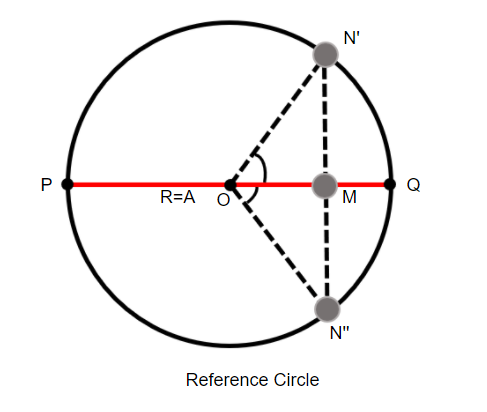
What is the reference particle and the reference circle?
Answer
423.6k+ views
Hint: When a particle is executing Simple Harmonic Motion, it is comparatively hard for us to analyze its motion. This is where the concept of a reference circle comes into play. It is a circle with its center as the point about which the particle is executing Simple Harmonic Motion and the radius being equal to the Amplitude of oscillation. We shall use this to further answer our question.
Complete answer:
A particle executing Simple Harmonic Motion has a fixed point about which it oscillates. This point is known as the center of our reference circle. Now, the amplitude of this SHM gives us the radius of the reference circle. This can be understood with the help of the following diagram:

In the above diagram, the particle (M) is executing SHM about the point O. The maximum displacement of the particle from O is at P and Q and this is the amplitude of its Simple Harmonic Motion. This is also equal to the radius of our reference circle.
Now, at this very instant the particle M has two shadows namely, (N’) and (N’’). These shadows of M on the circle are known as the reference points of M. These only move in a circular motion with a uniform speed.
Hence, the reference circle and the reference particle have been explained.
Note:
The two shadows of our particle ‘M’ indicate that we have taken two references. If we observe from above, the shadow will be cast on the lower hemisphere of the reference circle and if we observe the particle from below, the shadow will be cast on the upper hemisphere.
Complete answer:
A particle executing Simple Harmonic Motion has a fixed point about which it oscillates. This point is known as the center of our reference circle. Now, the amplitude of this SHM gives us the radius of the reference circle. This can be understood with the help of the following diagram:

In the above diagram, the particle (M) is executing SHM about the point O. The maximum displacement of the particle from O is at P and Q and this is the amplitude of its Simple Harmonic Motion. This is also equal to the radius of our reference circle.
Now, at this very instant the particle M has two shadows namely, (N’) and (N’’). These shadows of M on the circle are known as the reference points of M. These only move in a circular motion with a uniform speed.
Hence, the reference circle and the reference particle have been explained.
Note:
The two shadows of our particle ‘M’ indicate that we have taken two references. If we observe from above, the shadow will be cast on the lower hemisphere of the reference circle and if we observe the particle from below, the shadow will be cast on the upper hemisphere.
Recently Updated Pages
The correct geometry and hybridization for XeF4 are class 11 chemistry CBSE

Water softening by Clarks process uses ACalcium bicarbonate class 11 chemistry CBSE

With reference to graphite and diamond which of the class 11 chemistry CBSE

A certain household has consumed 250 units of energy class 11 physics CBSE

The lightest metal known is A beryllium B lithium C class 11 chemistry CBSE

What is the formula mass of the iodine molecule class 11 chemistry CBSE

Trending doubts
State the laws of reflection of light

Arrange Water ethanol and phenol in increasing order class 11 chemistry CBSE

One Metric ton is equal to kg A 10000 B 1000 C 100 class 11 physics CBSE

Difference Between Prokaryotic Cells and Eukaryotic Cells

A mixture of o nitrophenol and p nitrophenol can be class 11 chemistry CBSE

How do I convert ms to kmh Give an example class 11 physics CBSE




